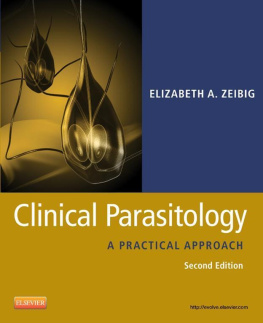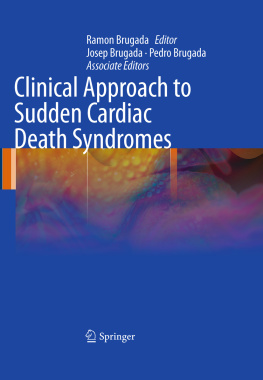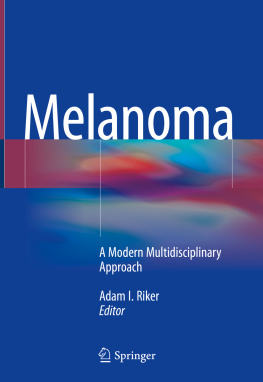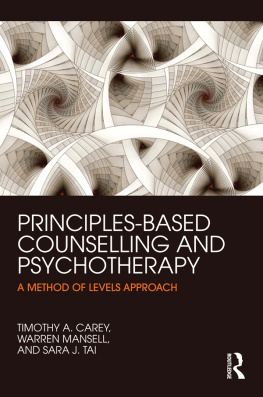A Primer
of Clinical
Interpretation
Philip F.D. Rubovits-Seitz

This book was set in 11 pt. New Baskerville by Alabama Book Composition of Deatsville, AL and printed and bound by Book-mart Press, Inc. of North Bergen, NJ.
Copyright 2002 by Jason Aronson Inc.
10 9 8 7 6 5 4 3 2 1
All rights reserved. No part of this book may be used or reproduced in any manner whatsoever without written permission from Jason Aronson Inc. except in the case of brief quotations in reviews for inclusion in a magazine, newspaper, or broadcast.
Library of Congress Cataloging-in-Publication Data
Rubovits-Seitz, Philip F. D., 1921
A primer of clinical interpretation / Philip F.D. Rubovits-Seitz.
p. ; cm.
Includes bibliographical references and index.
ISBN 978-0-7657-0361-3
1. Psychoanalytic interpretation. I. Title.
[DNLM: 1. Psychoanalytic Interpretation. 2. Psychoanalytic Therapymethods. WM 460 R897p 2002]
RC489.I57 R835 2002
616.89'17dc21
2002018295
Printed in the United States of America on acid-free paper. For information and catalog write to Jason Aronson Inc., 230 Livingston Street, Northvale, NJ 07647-1726, or visit our website: www.aronson.com
Contents
Part I:
The Classical Approach to Interpretation
Part II:
Some Postclassical Approaches to Clinical Interpretation
Preface
The purpose of this primer is to provide an introduction to clinical interpretation for students who are just beginning the study and practice of psychoanalysis or dynamic psychotherapy, and for more experienced clinicians who are interested in further study of clinical interpretation. The literature on clinical interpretation is surprisingly meager and does not convey the central role of interpretation in our clinical work. We have taken these methods largely for granted and have assumed that they are easier and more reliable than they actually are. A young colleague recently asked me, for example, Why should we study interpretation? Isnt it something we do by the seat of our pants? To answer the young colleagues question, I briefly reviewed the history of clinical interpretation in the depth psychologies.
During the first half-century of psychoanalysis, Freud and his followers assumed that their methods of inferring latent meanings and determinants were scientifically sound. Freud (1905) confidently and repeatedly claimed that it is easy to learn how to interpret dreams, to extract from the patients associations his unconscious thoughts and memories, and to practise similar explanatory arts; for these, the patient will always provide the text. When analysts had difficulty agreeing on the interpretation of the same case material, Freud dismissed their disagreements with the ironic comment, Quot capita, tot sensaas many heads, so many opinions. At the end of his career, however, Freud (1940) acknowledged that
Our justification for making such inferences and interpolations and the degree of certainty attaching to them of course remain open to criticism in each individual instance; and it cannot be denied that it is often extremely difficult to arrive at a decisiona fact which finds expression in the lack of agreement among analysts.
Nevertheless, he continued to insist that psychoanalytic methods of confirming interpretations are in every respect trustworthy (Freud, 1937).
The uncertainties of clinical inference did not surface clearly until the 1950s, when Edward Glover (1952) and Thomas M. French (1955), working independently of each other and employing different methods of investigation, reported disturbing indications that clinical interpretation may not be as easy or as reliable as Freud claimed. French was dismayed to find that individual analysts react differently to the same clinical data, and Glover expressed alarm at the variability of conclusions based on interpretations. French referred to this as the consensus problem; Glover called it the Achilles heel of psychoanalysis.
The reports by Glover and French led a group of psychoanalysts in Chicago to undertake a systematic investigation of the consensus problem. Coordinated by the present writer (Seitz, 1966), the research team attempted to make blind interpretations of various amounts and kinds of the same clinical data. We worked together for over three years but were never able to achieve satisfactory consensus on the blind interpretation of the same case material. Since then, numerous other investigators have documented the consensus problem.
Considering the limited reliability of clinical interpretations, it seems very appropriate, even necessary, for students and clinicians to study the process and problems of interpretation as thoroughly as possible.
The principal precepts of clinical interpretation that I emphasize in this primer include:
1. Giving priority to methods of understanding latent meanings and determinants, rather than to the techniques of communicating interpretations to patients.
2. Basing interpretations on clinical data rather than on clinical theories so that interpretations are specific to the individual patient.
3. Clinical data consist of what the patient actually says and does during sessions and what the therapist observes introspectively in his or her responses to the patient; everything else is inferred.
4. There is no Royal Road to the Unconscious, despite Freuds rhetorical statement to this effect. No particular type of clinical data is more useful for depth-psychological interpretation than any other; for example, dreams are only one among a wide variety of data that provide clues to latent meanings and determinants.
5. Limiting the use of theory in formulating interpretations to the basic general concepts (background assumptions) of psychoanalysis, in contrast to the use of specific clinical theories.
6. Clinical interpretation attempts to understand both latent meanings and determinants.
7. The importance of imaginative conjecture (inductive leaps) in the construal (constructive) phase of the interpretive processwhat Freud referred to as hitting on a clever idea.
8. The hermeneutic concept of the interdependent relations between whole and part meanings: the whole is derived from and constituted by the parts, the parts being delineated and integrated by the whole.
9. The fallibility of constructions, which necessitates checking and justifying the correctness of interpretive hypotheses.
10. Facilitating the gradual development of self-interpretive competence in the patient.
This primer is divided into two parts: includes some of the best-known postclassical approaches, presented in order of their increasingly divergent views from the classical approachwith the exception of the final chapter on Pluralistic Approaches, which combine the classical and postclassical approaches.
REFERENCES
French, T. (1955). The problem of consensus. Paper presented to the panel on Validation of Psychoanalytic Techniques, rep. J. Marmor. Journal of the American Psychoanalytic Association, 5, 496505.
Freud, S. (1905). Fragment of an analysis of a case of hysteria. Standard edition (Vol. 7, pp. 301324). London: Hogarth, 1956, p. 116.
. (1937). Constructions in analysis. Standard edition (Vol. 23, 255270). London: Hogarth, 1964, p. 263.
. (1940). An outline of psychoanalysis. Standard edition (Vol. 23, 141208). London: Hogarth, 1964, p. 197.









